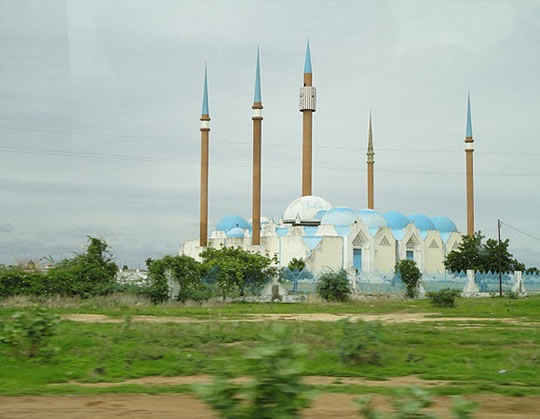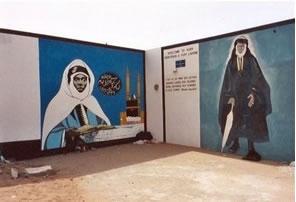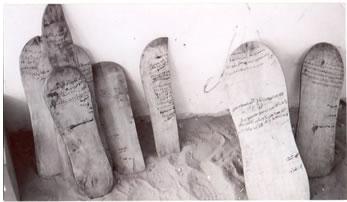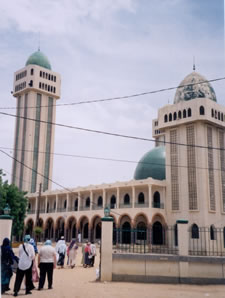Project Themes

Islam in and Liberation Theology
by Dr. W.F. Santiago-Valles
Introduction


- The religion of traveling Arab merchants was Africanized
- New rituals are used to connect traditional practices that organize daily life
- New communities are created through ways of remembering
- African Muslims acquired awareness of their place in the world
Full Article
 The teaching materials in artifact box #3 can be used to discuss how Islam, as a way of life, organizes the way people in Africa remember. One of the larger questions is how those memories of Islam in Africa organize daily life and a sense of place in the world. The other large question is how those memories are transmitted from one generation to another within the same country and among migrants dispersed across the world. In the second question popular culture becomes important as one of the ways in which particular memories are transmitted and reassembled.
The teaching materials in artifact box #3 can be used to discuss how Islam, as a way of life, organizes the way people in Africa remember. One of the larger questions is how those memories of Islam in Africa organize daily life and a sense of place in the world. The other large question is how those memories are transmitted from one generation to another within the same country and among migrants dispersed across the world. In the second question popular culture becomes important as one of the ways in which particular memories are transmitted and reassembled.
Islam appeared in Africa with the commercial networks connecting China , India , the Arabian peninsula , Africa and the Iberian peninsula [between the 700s-900s]. Later the predatory economy of the European slave trade [1470s-1890s] played a large part in making Islam the religion of the majority who opposed enslavement and domination.
That centuries old economic system of trans-continental domination [in farming, trade, industry, finance, and transmission of information] is now called globalization. During this long period, African Muslims created innovations and adaptations that rejected the imposed economic and cultural order. That is why Islam in Africa is related to the transmission of memories using popular cultures. By popular cultures, we mean the daily efforts to assert a collective disagreement with the systems of domination, questioning the basis for their justification and giving solutions to the problems of daily life.
Globalization as in a world market system has been around since the 13th Century according to Abu-Lughod, Gunder Frank and Chaudhuri. Some of the recommended sources about globalization are:
- The essays in the web site http://www.monbiot.com/archives/category/globalisation [NEW LINK NEEDED] of George Monbiot who writes a column for The Guardian in Britain . The "Life" series of thirty 24 minute videos from Bullfrog Films (USA).
- Aijaz Ahmad, Globalization and Culture. In On communalism and globalization. New Delhi : Three Essays Press, 2002. pp. 95-120.
 Connecting the collected artifacts for the teaching units required first of all locating the global encounter of Africans with Arabs, Asians, Europeans, and people from the Americas . In order to see how the artifact and its producers are challenging the relations of domination it is necessary to understand the society and the world in which that encounter took place. How was the production of basic needs and tools organized? How was nature controlled and by whom? How was wealth created and distributed? Whatever the answers to those questions are,another important one is how was that arrangement of global domination justified, by whom and for how long? Some of the sources recommended to do this are:
Connecting the collected artifacts for the teaching units required first of all locating the global encounter of Africans with Arabs, Asians, Europeans, and people from the Americas . In order to see how the artifact and its producers are challenging the relations of domination it is necessary to understand the society and the world in which that encounter took place. How was the production of basic needs and tools organized? How was nature controlled and by whom? How was wealth created and distributed? Whatever the answers to those questions are,another important one is how was that arrangement of global domination justified, by whom and for how long? Some of the sources recommended to do this are:
- Ibn-Battuta, Ibn-Battuta in Black Africa . (Eds. S. Hamdun & N.Q. King). Princeton , NJ : Markus Wiener, 1995 [about his travels during the 14th Century across Africa ), and
- N. Levtzion & R. L. Pouwels (Eds.), The History of Islam in Africa . Athens : Ohio University Press, 2000 (for general information)
Explaining the objects used in the rituals that give meaning to a group and that are considered important, depends on understanding culture as processes of direct experience with constant struggle. One of those processes is daily life in the village or region and more specifically the conflict between groups resisting marginalization and groups imposing it. Not all the Islamic brotherhoods in Africa accommodated themselves to foreign domination past and present. Some have created regional networks of obligations based on shared interests with other resistance movements whose continued relevance confirm the present crisis of the nation state. The ideas and objects these African brotherhoods produced speak to the struggle between remembering and forgetting, as well as between nationalism and internationalism. Some of the sources recommended are:
- Two books by David Robinson for more specific information, The Holy War of Umar Tal . Oxford : Clarendon Press, 1985 and Paths of Accommodation. Muslim societies and the French colonial authorities in Senegal and Mauritania, 1880-1920. Athens : Ohio University Press, 2000.]
- Another David Robinson book: Muslim Societies in African History . Cambridge, UK: Cambridge University Press, 2004
- Lucy Behrman, Muslim Brotherhoods & Politics in Senegal (1999)
- Visit The Fowler Museum (UCLA) Passport to Paradise exhibit.
 The present collaboration between international financial institutions and the government administrators of the debtor countries explains the ongoing impact of "structural adjustment". The result is both migration from the rural to the urban areas in coastal Africa , and then from those cement monuments to growing underdevelopment out to Europe , Asia , and North America . The consequences of their displacement and the institutions the migrants create to produce forms of remembering are the cornerstones of a comparison tool developed by Dr. Santiago-Valles and his Senegalese counterpart, Dr. Ibrahima Thioub for the ongoing research work in this area.
The present collaboration between international financial institutions and the government administrators of the debtor countries explains the ongoing impact of "structural adjustment". The result is both migration from the rural to the urban areas in coastal Africa , and then from those cement monuments to growing underdevelopment out to Europe , Asia , and North America . The consequences of their displacement and the institutions the migrants create to produce forms of remembering are the cornerstones of a comparison tool developed by Dr. Santiago-Valles and his Senegalese counterpart, Dr. Ibrahima Thioub for the ongoing research work in this area.
Santiago-Valles is also available for classroom lectures about the comparison tool created and for professional development workshops with schoolteachers interested in discussing ways to use it with the other teaching materials provided. Thioub is available by email at ceddo@tekrur.org. For more general information about this kind of comparative research device, the source recommended is:
- Regina Jere -Malanda , Immigrants, the real story. In the New African . (June 2004), pp. 8-15
- B. Anderson, The Spectre of Comparisons . London : Verso, 2000.
There is a history of popular culture movements in Africa that opposed the slave trade, colonial domination and the imposition of technologies that further marginalized subjugated populations. These global movements were predecessors to the present globalization of resistance to, what Samir Amin in Senegal calls, the senile monopoly of private investment funds. The sectors where these private investor funds dominate are in the extraction of natural resources, information technologies, military supplies and international loans. The sources recommended are two books with sections about Islam and Africa included in the # 3 artifact box:
-
Samir Amin, Au-dela du capitalisme Se'nile [Beyond senile capitalism]. Paris : Presses Universitaire de France, and
-
Samir Amin, Mondialisation des Resistances. L'Etat des luttes [Globalization of resistance.The state of the struggles]. Paris : L'Harmattan, 2002, and
About popular culture movements in Africa the sources recommended include:
- Sylvia Federici, The new African student movement. In C. Mwaria, S. Federici , & J. McLaren (Eds.). African Visions. Literary images, political change, and social struggle in contemporary Africa (pp. 49-66). London : Praeger, 2000.
- Allen F. Roberts & Mary Nooter Roberts, A Saint in the City. Sufi arts in Urban Senegal . Los Angeles , CA ; UCLA Fowler Museum of Cultural History, 2003.
- Robin Denslow, When the music's over. The story of political pop. London : Faber & Faber, 1990.
- S. Bachir Diagne, La Lecon de la musique. Reflexions sur une politique de la culture [The lesson of the music. Reflections about a politics of culture]. In M.C. Diop (Ed.) Le Senegal Contemporain. ( Paris : Khartala, 2002) pp. 243-259